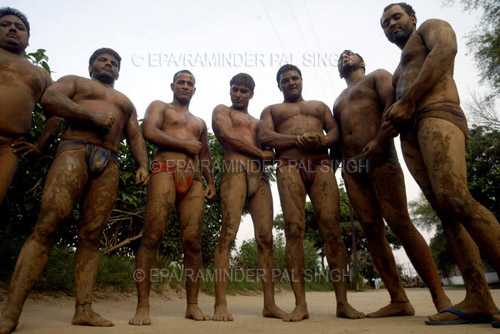INDIA TRADITIONAL WRESTLING


Wrestlers pose for a photograph after their daily workout session at 'Akhara Krishan Pehalwaan' in Amritsar city, India, 16 July 2008. Indian form of wrestling which is known as 'Kushti' is an ancient form of warriorship where training is imparted in an 'Akhara', which is more like a temple-gymnasium dedicated to the Hindu God, Lord Hanumaan. Each 'Akhara' has a Guru or the Master whose wisdom guides the training of the wrestlers. In traditional Indian wrestling or 'Kushti', the wrestling match is played in the square dark red clay ground. The young wrestlers usually train two times a day; in the early morning and in the evening, six days a week. Indian wrestlers subscribe not only to a set of wrestling exercises but to a more elaborate way of life, i.e. diet, spirituality, ethics, etc. In the modern times, the gyms are preferred over 'Akharas' and a sculpted body is preferred over skilled fingers of a traditional wrestler. The trend of joining the 'Akharas' has diminished over the years.
| India Traditional 1 | |
 | |
Art of South India

SOUTH INDIA'S traditional paintings, which added lustre to both temple precincts and palaces in the heyday of their royal patronage, are witnessing a sustained and quiet renaissance today.
There has been a revival of Tamil Nadu's Thanjavur and Karnataka's Mysore schools of art as well as Andhra's Kalamkari work in recent years, while Kerala's murals are now being transposed on canvas and paper, bringing to life yet another heritage temple art.
While keeping to traditional painting styles and formats, today's artists bring new themes and contemporary sensibilities to the art forms, investing them with a fresh perspective.
An exhibition of Thanjavur, Mysore paintings and kalamkari, mural art is being organised by RAASI Foundation, titled `Pristine Expressions of Ancient Art.'

It reflects the brilliant colours, rich mythology and techniques from which art forms draw their inspiration as they evolve into more contemporary format, look and language.
Fine lines and subtle differences in the techniques of Thanjavur and Mysore schools are brought out in a series of traditional frames celebrating Baby Krishna and Radha-Krishna themes, Ramarpattabishekam, Shiva-Parvati themes and representation of Ganesh Parvati, Lakshmi and Saraswati.
The Thanjavur ones are gem-encrusted, embellished with gold foil and with a fine sense of faithful reproduction.
Among the compelling pieces are a Radhakrishna done in the North India Calender art style, executed with Thanjavur technique, Gajalakshmi in hues of rich red, green and blue with intricate gold relief work and a `Rishabh Vahanam' portraying Lord Shiva seated on Rishabh with Parvati.
The delicately executed Mysore paintings have mythological themes. The absence of gold foil and gems is made up by superb detailing in the folds and textures of clothing, in the exquisitely delineated flowers in garlands and even in facial expressions. The colours are rich too. The kalamkari pieces reflect excellence in technique, narrative form and use of colours. The kalamkari panels and pieces display a fine blend of harmony and movement.
Kerala's mural or `Suvar art,' originally done on treated temple walls and now on paper, has a distinct style and imagery.

The background is made to look like a treated wall and the boldly executed mythological figures such as Krishna, Mahabali and so on are faintly reminiscent of the faces of the Kathakali dancers.




0 Comments:
Post a Comment